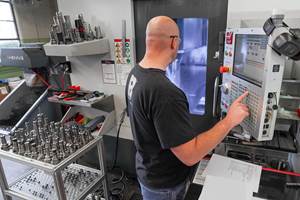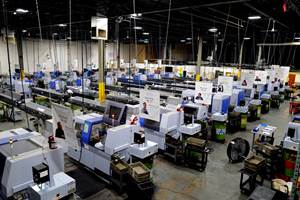Machining, Disruption and the Years Ahead
Three major technological advancements have changed modern manufacturing. Pay attention or get left behind.
Share





The machining industry sits on a precipice—an edge, a turning point, a revolution—one that is coming whether we want it or not. We’ve seen it before, and it has everything to do with technological advancements. They are already here, challenging old-school thinking and disrupting the industry in ways that force us to change our thinking. But there is a divide between those who embrace change and those who dig in their heels. The challenges of the future are not going away—just look at how much the industry has changed in the past 20 years. In order to exist rather than become extinct, we need to look at the greatest disruptions to machining.
3D Printing
3D printing has flooded the machining industry causing some causalities for those who haven’t been able to tread water. It’s hit areas like prototyping and pattern makers with devastating force. Those who didn’t update their equipment and processes are closing their doors, yet this is just the beginning. As the technology becomes more robust in the coming years, it will take over other areas causing more companies to close up shop. Will it take over everything? I don’t think so, not in the next five to 10 years. However, the technology is still evolving. We would do well to monitor 3D printing’s advancements and make sure not to discount it.
Internet of Things (IoT)/Big Data
This is a big advancement, and it’s the fastest moving, most disruptive one. Having already revolutionized the consumer market with voice-activated speakers and IoT home technology, big data is now hitting the industrial sector hard and fast, providing the metalworking industry with methods for increased productivity. Of course, this means the companies that don’t embrace the coming of IoT will be left behind. For metalworking shops, big data enables us to monitor machines and processes, receive data and take action faster than ever before—all of which translates to wiser decisions. Much of this data will be in the cloud and come under the name Industry 4.0 or the Fourth Industrial Revolution.
It’s coming, so it’s important to embrace it now so you don’t get left behind. The past teaches us a lot, and right now, if you want to stay in the game, you have to wise up, get up-to-date and embrace the changes coming.
Robotics
With the lack of skilled labor, companies are turning to robotics and automation. The industry is trending toward replacing manually and cognitively repetitive tasks with some form of automation. This change is inevitable; it’s the nature of progress. Despite this fact, many metal shops shy away from robotics, claiming they don’t have enough volume or that it’s just too complicated. These excuses are anchored in the past, when automation and robotics were complicated and difficult for the layman to understand. Well, things have changed. The advancements have been incredible. What was once complicated is now simple and user-friendly. Thousands and thousands of robots and automation assistants are now being sold every year as they become cheaper and easier to program. So, what’s stopping you?
The integration of robotics and automation is changing both large and small machine shops. As technology becomes easier to use, more machine shops are benefiting from reduced operation costs and increased productivity. I look at robotics as a tool to increase the capacity of our workforce, and as assistive tools to help our employees and companies become globally competitive.
I haven’t covered all the technologies disrupting the industry today or touched on the ones around the corner, but the message is clear: Technology is only going to disrupt the shops and companies that aren’t willing to embrace change. Ignoring robotics today is not an option.
Related Content
Medical Shop Performs Lights-Out Production in Five-Axes
Moving to five-axis machining enabled this shop to dramatically reduce setup time and increase lights-out capacity, but success relied on the right combination of workholding and automation.
Read MoreIncreasing Productivity with Digitalization and AI
Job shops are implementing automation and digitalization into workflows to eliminate set up time and increase repeatability in production.
Read MoreInside the Premium Machine Shop Making Fasteners
AMPG can’t help but take risks — its management doesn’t know how to run machines. But these risks have enabled it to become a runaway success in its market.
Read MoreUsing Automation to Reduce COGS and Stay Globally Competitive
Decade-long, multiphase automation investments lower operating costs and maintain technology lead in an increasingly competitive global market.
Read MoreRead Next
How I Made It: Dennis Rymanowski
Dennis Rymanowski has worked at NSH USA for 60 years, with his passion for manufacturing living alongside his passion for his family’s polka band.
Read MoreA New Frontier in Surface Finish Control
What if your machine tool could measure surface roughness as it cuts? This article explores how in-process metrology is advancing from concept to reality, enabling real-time feedback, immediate detection of anomalies and new levels of control over surface quality. Discover the technologies making this possible.
Read More





















